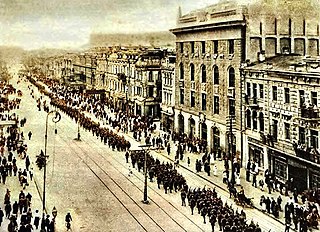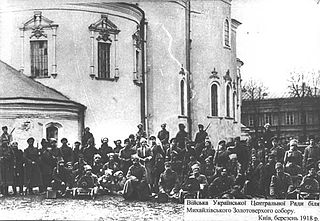 W
WThe Battle of Boryspil happened on June 2, 1920, near the town of Boryspil near Kiev. It was fought between the Polish and Russian forces during the Polish-Bolshevik War and was a part of the Polish counter-assault after the ill-fated Russian offensive of May 27.
 W
WDuring the Polish-Soviet War of 1920 the city of Lwów was attacked by the forces of Alexander Ilyich Yegorov. Since mid-June 1920 the 1st Cavalry Army of Semyon Budyonny was trying to reach the city from the north and east. At the same time Lwów was preparing its defenses. The inhabitants raised and fully equipped three regiments of infantry and two regiments of cavalry as well as constructed defensive lines. The city was defended by an equivalent of three Polish divisions aided by one Ukrainian infantry division. Finally after almost a month of heavy fighting on August 16 the Red Army crossed the Southern Bug River and, reinforced by additional 8 divisions of the Red Cossacks, started an assault on the city. The fighting occurred with heavy casualties on both sides, but after three days the assault was halted and the Red Army retreated. With the crushing defeat of the main forces of the Red Army in the battle of Warsaw, and the Polish victories at Komarów and Zadwórze, the Russian forces were forced to retreat from Lwów.
 W
WThe First Winter Campaign was a campaign between the army of the Ukrainian People's Republic (UPR) and Bolshevik forces in Ukraine during the Ukrainian-Soviet War. It began on December 6, 1919, and lasted until May 6, 1920. The main task of the Winter Campaign was to maintain the presence of the Ukrainian army on Ukrainian territory and in enemy territory, through guerrilla action. At the end of November 1919, the remnants of the UPR Army were surrounded (Lyubar-Chortoria-Myropil). The Galician Army, due to Petliura's appeasement with the Poles, was forced to join General Denikin's Russian Volunteer Army after November 6, 1919. The Ukrainian People's Army troops were surrounded by three enemy armies — the Red Army, Volunteer Army and Polish Army ; in addition, Ukrainian units suffered from the typhus epidemic. On December 6, 1919, at a military meeting in Nova Chortoria, it was finally decided to carry out a winter campaign by units of the UPR and the rear of the Volunteer Army. About 5,000 people took part in the campaign against the Red and Volunteer Armies. However, the composition of the combat-ready units numbered 2,000 bayonets, 1,000 sabers and 14 guns.
 W
WThe Galician Soviet Socialist Republic was a Bolshevik's self-declared and short-lived political entity that existed from 15 July to formally 21 September 1920. The communist state was established during a successful counter-offensive of the Red Army in the summer of 1920 as part of the Polish-Soviet War and in the course of which the Polish-Ukrainian joint military force was forced to retreat from its positions along the Dnieper that it secured earlier in 1920 all the way to the foothills of the Carpathian Mountains.
 W
WThe 1920 Kiev Offensive, sometimes considered to have started the Polish–Soviet War, was an attempt by the armed forces of the newly re-emerged Poland led by Józef Piłsudski, in alliance with the Ukrainian leader Symon Petliura, to seize the territories of modern-day Ukraine which fell under the Soviet control after the Bolshevik Revolution. The operation led to a Soviet counteroffensive resulting in the creation of the short-lived Galician Soviet Socialist Republic, and ended with the formal Peace of Riga of 1921.
 W
WThe 1920 Kyiv Victory Parade was a joint Polish-Ukrainian parade military parade on 9 May 1920 in the Ukrainian capital of Kyiv. It was held on Khreschatyk Street on the occasion of the liberation of the city from the Bolshevik Red Army in the Kyiv Offensive. It was the first formal military parade to be held in the Ukrainian People's Republic.
 W
WThe Odessa operation is an offensive operation during the Russian Civil War of the South Western Front of the Red Army against the Novorossiysk Oblast Army Group of the White Armed Forces of South Russia. The operation was a success for the Red Army, as Odessa was taken on February 8 and, despite the organisation of an evacuation over the Black Sea supported by the British Navy, many White soldiers and material were captured.
 W
WThe Government of South Russia was a White movement government established in Sevastopol, Crimea in April 1920.
 W
WThe South Russian Government was a Russian White movement government established by Armed Forces of South Russia commander Anton Denikin in Novorossiysk, Kuban, in March 1920 during the Russian Civil War.
 W
WThe Treaty of Trianon was prepared at the Paris Peace Conference and was signed in the Grand Trianon Palace in Versailles on 4 June 1920. It formally ended World War I between most of the Allies of World War I and the Kingdom of Hungary. French diplomats played the major role in designing the treaty, with a mind to establishing French-led coalition of the newly formed nations. It regulated the status of the independent Hungarian state and defined its borders generally within the ceasefire lines established in November–December 1918 and left Hungary as a landlocked state that included 93,073 square kilometres (35,936 sq mi), 28% of the 325,411 square kilometres (125,642 sq mi) that had constituted the pre-war Kingdom of Hungary. The truncated Kingdom had a population of 7.6 million, 36% compared to the pre-war kingdom's population of 20.9 million. Though the areas that were allocated to neighbouring countries had a majority of non-Hungarians, in them lived 3.3 million Hungarians – 31% – who were now in a minority status. The treaty limited Hungary's army to 35,000 officers and men, and the Austro-Hungarian Navy ceased to exist. These decisions and their consequences have been the cause of deep resentment in Hungary ever since.
 W
WThe Ukrainian People's Republic (UPR), or Ukrainian National Republic (UNR), was declared in Ukraine following the February Revolution in Russia. It initially formed part of the Russian Republic, and proclaimed its independence from the Russian Soviet Republic on 25 January 1918. During its short existence the republic went through several political transformations - from the socialist-leaning republic headed by the Central Council with its general secretariat to the national republic led by the Directorate and by Symon Petliura. Between April and December 1918 the Ukrainian People's Republic did not function, having been overthrown by the pro-German Ukrainian State of Pavlo Skoropadsky, who proclaimed himself Hetman. From late 1919 the UNR operated as an ally of the Second Polish Republic, but by then the state de facto no longer existed in Ukraine. The 18 March 1921 Treaty of Riga between the Second Polish Republic, Soviet Russia and of Soviet Ukraine sealed the fate of the Ukrainian People's Republic.
 W
WThe Civil War in Ukraine is the term commonly used in post-Soviet Ukraine for the events taking place between 1917–21, nowadays regarded essentially as a war between the Ukrainian People's Republic and the bolsheviks. The war ensued soon after the October Revolution when Lenin dispatched the Antonov's expeditionary group to Ukraine and Southern Russia.